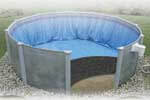FREE Standard Shipping On All Orders $100 or More!*
Nutgrass Problems in Vinyl Pools
For vinyl liner pool owners, the only thing between the water and the earth is a thin sheet of vinyl. If this vinyl gets punctured, torn or ripped, it's game over. Protecting your pool liner is therefore very important, poor water chemistry, heavy branches, non-pool toys - all represent threats that must be avoided.
But these threats are from inside the pool, and for many Americans, a larger danger looms just outside of the pool, or beneath the pool, actually.
NUTGRASS! Also known as Nutsedge, nutgrass is a weed that looks very much like grass, and one that springs forward from an underground tuber, or root that resembles a peanut. The crazy thing about nutgrass is the fantastic strength and tenacity in the tiny weed - it can push up through asphalt, concrete, and yes - pool liners. Nutgrass can grow underneath the pool, and push up through your liner, puncturing holes in the vinyl, and looking like tiny blades of seagrass.
According to Intex "Certain types of vigorous grasses, including Nut Grass aka Nut Sedge, St. Augustine and Bermuda grasses, can grow through the liner." And, of course this is not covered by warranty.
HOW TO STOP NUTGRASS FROM GROWING THROUGH A POOL LINER
There are a couple of tried and true methods for removing, killing or stopping nutgrass from growing underneath the pool, damaging pool liners, and siphoning away your heated and treated pool water.

1. DIG UP THE NUTS
Nutgrass or nutsedge begins several inches below the surface. Some tubers can be as much as 12" below the surface, and if the 'nut' is not removed, the grass will grow again. If the roots are simply broken, but the tuber (nut) is not removed, it will regenerate.
A shovel and a pick and a half-a-day's labor will allow you to separate and remove the nutgrass tubers from the soil. Or if you have heavy equipment available, you can scoop out the infected soil and replace with soil or sand not contaminated with nutgrass.
2. STERILIZE THE SOIL
In this method, all grasses should be removed and the area roto-tilled to disturb the soil. Several nutgrass removers can be found at your local home and hardware store. Glyphosate, aka Round-Up is one that will kill nutsedge. SedgeHammer is another product that kills most types of sedge weeds. Other forms of weed killers may not kill the root (nut) however.
Salt and/or Sugar can also be used to kill nutgrass by making the soil unsuitable for plants. Mild acids can also be used, such as white vinegar, sprayed directly onto the plants in copious quantity. Natural methods such as these may be less effective or less complete however.
3. GEOTEXTILE BARRIER

You may be familiar with aboveground pool vinyl floor pads (or maybe not), these are geotextiles, a woven fabric that is nearly impenetrable, due to the interlocking design of the weave. Sold under names like Gorilla Pad, Elephant Pad or our own Armor Shield Liner Pad, these are sized to fit your aboveground pool, and are placed under the liner directly on the soil.
WHAT IF NUTGRASS IS ALREADY GROWING THROUGH MY LINER?
If you find that nutgrass is already growing through the liner, in your otherwise beautiful blue pool - it can be a devastating sight. Besides now having live plants in the pool, you now also have (many) holes in your pool liner.
In cases of large scale nutgrass problem in a vinyl pool, you will need to remove the liner, and replace the liner, using a Liner Pad, over top of treated or replaced soil or sand.
If the nutgrass infestation is not too large, there is another method proposed by our friends at Inyopools. That is to pluck out the grass, and using a syringe, inject Glyphosate (Round-Up) into the small hole and then quickly patch the hole with a vinyl patch kit.
Cyperus rotundus is one of the most invasive weeds known, having spread out to a worldwide distribution in tropical and temperate regions. It has been called "the world's worst weed" as it is known as a weed in over 90 countries, and infests over 50 crops worldwide. In the United States it occurs from Florida north to New York and Minnesota and west to California and most of the states in between. (Wikipedia)